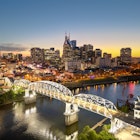
Exploring Zemun, BelgradeвҖҷs most atmospheric quarter
Apr 26, 2019 вҖў 4 min read

View over Zemun's quaint rooftops and the Danube from іТІ№°щ»еҙЗЕЎ Tower © Evgeni FabisukВ / Shutterstock
No visit to Belgrade is complete without at least half a day spent in Zemun. This picturesque neighbourhood on the DanubeвҖҷs right bank was formerly a separate town, located across the river from central Belgrade.
Although formally part of the Serbian capital since 1934, Zemun still retains its distinct identity and a small-town feel. This is not surprising given that between 1739 and 1918 Zemun was not even in the same state as Belgrade вҖ“ for those two centuries, it was part of the Habsburg Empire, while Belgrade was first a border city in the Ottoman Empire and then the capital of the newly independent Serbian kingdom.

The most obvious reminder of ZemunвҖҷs time as an Austro-Hungarian border town is its most iconic sight вҖ“ the Janos Hunyadi tower, better known as іТІ№°щ»еҙЗЕЎ. The brick-and-stone tower rises from the middle of the remains of a medieval square citadel, and offers some of the most beautiful views of Belgrade across the Danube, over red-tiled rooftops and ornate church steeples. ItвҖҷs named after a Hungarian hero who died here after defending Belgrade from the Ottoman siege of 1456, and was built in 1896 to mark the 1000th anniversary of Hungarian settlement in central Europe.
Next to the tower is ZemunвҖҷs cemetery, where elaborate tombs stand as relics of its multicultural past. Among many wonderful turn-of-the-20th-century memorials and more recent hyper-realistic sculptures marking the graves of infamous Serbian criminals, watch out for the graves of Rebecca and Simon Herzl, paternal grandparents of Theodore Herzl. The founder of modern Zionism, Herzl was allegedly inspired in his thinking by a famous Zemun-based rabbi, Yehuda Alkalai.

Although Zemun lost most of its Jewish and German residents during and after WWII, its lower town still bears traces of former cultural diversity, with its main Orthodox, Catholic, Protestant and Jewish places of worship all located not far from each other. Just below іТІ№°щ»еҙЗЕЎ, the 18th-century baroque Nikolajevska Church вҖ“ BelgradeвҖҷs oldest and ZemunвҖҷs most beautiful вҖ“ is filled with faded monochrome frescoes and many relics which give it an eerie, ancient feel. Close to ZemunвҖҷs city park stands BelgradeвҖҷs only functioning , dedicated to John the Baptist, and a short walk from there is the former Ashkenazi synagogue (which now, somewhat bizarrely, houses a ).
Architecture aficionados will also enjoy many monumental modernist buildings that were built in Zemun between the two world wars, from the Lutheran Evangelical rotunda in ToЕЎin bunar street, to the hulking art-deco Air Force Command building at AvijatiДҚarski trg. The latter was bombed during the 1999 NATO airstrikes and has not been repaired since, but itвҖҷs still one of the most graceful buildings in Belgrade featuring a giant art-deco statue of Icarus on its side. You should also check out the faded Hotel Jugoslavija, which used to be the epitome of Yugoslav socialist luxury, hosting the likes of Queen Elizabeth II, Richard Nixon and Neil Armstrong in its heyday.

Apart from gorgeous architecture, ZemunвҖҷs other defining feature is its small-town atmosphere, best experienced at the market which stands between the central Veliki trg and Masarikov trg. Zemun market is considered to be one of the best in Belgrade, and it offers a great variety of local dairy and meat produce which the merchants will normally allow you to taste. If youвҖҷre a bit more peckish, you can also snack on girice (fried small fish) which are sold at the many of the marketвҖҷs fishmongers, or try one of BelgradeвҖҷs best bureks (cheese or meat pies) at nearby PetroviДҮ bakery on Veliki trg.
ZemunвҖҷs culinary scene is a big draw for Belgraders, who come to many restaurants lining the Danube promenade to feast on river-fish dishes and the beloved spicy riblja ДҚorba (fish broth). The venues range from informal budget joints frequented by fishermen, like , to more upscale places such as , and Е І№°щІ№ІФ. If river fish is not your thing, consider trying excellent traditional grills at , steaks at or local home-cooked food at cosy .

In addition to delectable food, ZemunвҖҷs restaurants are famous for live music and raucous atmosphere in the evenings. In the past few decades, Reka acquired an almost mythical reputation and youвҖҷd be considered lucky if you can nab a table there on Fridays and Saturdays. If youвҖҷre looking for a casual place to grab a drink and enjoy the view of the Danube, look no further than , a local craft brewery located inside an old slaughterhouse, or pub, just below іТІ№°щ»еҙЗЕЎ, which also brews its own beer.
On warm summer days, you can take a dip in the Danube. During July and August, a pontoon bridge connects Zemun with the Great War Island where you can relax on the beach or go for a stroll around the protected nature reserve. Alternatively, try stand-up paddleboarding at beach bar beside Hotel Jugoslavija, which allows you to see Zemun at its most beautiful from the river, as the sun sets below іТІ№°щ»еҙЗЕЎ tower.
https://shop.lonelyplanet.com/products/eastern-europe-travel-guide-14
Explore related stories





 Festivals & EventsChristmas dinners around the world: choose your favorite festive dishes
Festivals & EventsChristmas dinners around the world: choose your favorite festive dishesNov 22, 2024 вҖў 5 min read
 Destination PracticalitiesA first-time guide to the Grand Egyptian Museum
Destination PracticalitiesA first-time guide to the Grand Egyptian MuseumNov 22, 2024 вҖў 8 min read

 BeachesThese 5 day trips from Sydney will show you the splendors of New South Wales
BeachesThese 5 day trips from Sydney will show you the splendors of New South WalesNov 22, 2024 вҖў 7 min read
 Destination PracticalitiesDo you need a visa to visit Thailand? HereвҖҷs everything to know
Destination PracticalitiesDo you need a visa to visit Thailand? HereвҖҷs everything to knowNov 22, 2024 вҖў 8 min read
